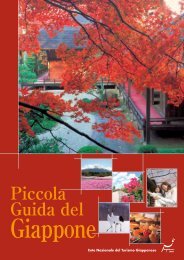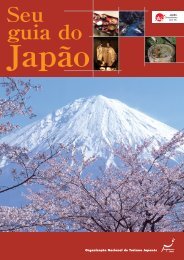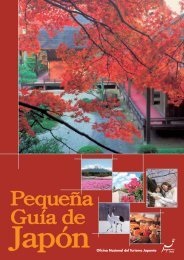Your Guide to - Japan National Tourist Organization
Your Guide to - Japan National Tourist Organization
Your Guide to - Japan National Tourist Organization
You also want an ePaper? Increase the reach of your titles
YUMPU automatically turns print PDFs into web optimized ePapers that Google loves.
As for traditional fine arts in the Kansai region, the<br />
Fujita Art Museum in Osaka is important due <strong>to</strong> its<br />
rich collection of antique fine arts. Note, however,<br />
that it opens only in spring and autumn. Also<br />
celebrated are the Osaka Municipal Museum of<br />
Oriental Ceramics, which specializes in priceless<br />
antique ceramics from China and Korea, and the<br />
Osaka Municipal Museum of Art with its rich<br />
collection of Chinese, and <strong>Japan</strong>ese antique fine art<br />
works. The Oyamazaki Villa Museum of Art in Kyo<strong>to</strong><br />
is an impressive villa structure placing pottery<br />
masterpieces on exhibit in a relaxing and serene<br />
atmosphere. The Miho Museum in Shiga prefecture<br />
features masterpieces of <strong>Japan</strong>ese fine art and<br />
ancient art from around the world. Note, however, it<br />
closes during winter. Meanwhile, Osaka's Sun<strong>to</strong>ry<br />
Museum TEMPOZAN holds theme exhibitions<br />
focusing on posters.<br />
Gardens<br />
<strong>Japan</strong>ese gardens, which excel in the creation of<br />
symbolic miniature replicas of entire seas or<br />
landscapes within the restrictions of a few hundred<br />
meters or less, are renowned around the world.<br />
Evolving from the sponsorship of a highly refined<br />
ruling class and the principles of Buddhism and<br />
Shin<strong>to</strong>ism, <strong>Japan</strong>ese gardens are ravishing<br />
combinations of plants, sand, water and rock that<br />
celebrate the beauties of nature in a structured<br />
artistic form. Numerous gardens are found on the<br />
grounds of temples, and many are centuries old.<br />
Kyo<strong>to</strong> is particularly rich in gardens, with those of<br />
Katsura Imperial Villa, Ginkakuji and Kinkakuji<br />
Temples, Nijo Castle and the famous rock garden of<br />
Ryoanji Temple being especially exquisite<br />
examples.<br />
In Tokyo, recommended gardens include Higashi<br />
Gyoen Garden, Hama Rikyu Garden and<br />
Koishikawa Korakuen, while the large now public<br />
park of Shinjuku Gyoen was originally a pleasure<br />
ground of the Imperial family.<br />
Elsewhere across the country, notable gardens<br />
include Kenrokuen of Kanazawa in Ishikawa<br />
Prefecture, Kairakuen in Ibaraki Prefecture,<br />
Kenrokuen, Kanazawa<br />
© Ishikawa Prefecture <strong>Tourist</strong> Association and Kanazawa Convention Bureau<br />
Korakuen in Okayama Prefecture and Ritsurin Park<br />
in Kagawa Prefecture.<br />
Classic Performing Arts<br />
<strong>Japan</strong>'s Noh drama is a highly stylized stage art<br />
with 700 years of his<strong>to</strong>ry. Richly symbolic, Noh is<br />
rooted in ancient Shin<strong>to</strong> rites and is performed on a<br />
stage which is roofed like a Shin<strong>to</strong> shrine. Ac<strong>to</strong>rs<br />
wear masks, and movement is highly stylized, while<br />
the costumes are usually rich and gorgeous.<br />
This classic art form is performed in Tokyo's<br />
<strong>National</strong> Noh Theater, the Hosho Nohgakudo, the<br />
Kanze Nohgakudo, and the Kita Nohgakudo. In the<br />
Kansai region, Noh is staged at the Kanze Kaikan in<br />
Kyo<strong>to</strong> and the Osaka Nohgaku Kaikan. Noh, on the<br />
other hand, is perhaps best appreciated at open-air,<br />
<strong>to</strong>rch-lit performances at temples.<br />
Noh<br />
Kabuki Theater is <strong>Japan</strong>'s secular classical drama,<br />
with vivid makeup, spectacular costumes and sets,<br />
plus dramatic action that includes sword-fighting,<br />
dancing, and even ac<strong>to</strong>rs flying from and <strong>to</strong> the stage<br />
over the audience.<br />
The best venue for Kabuki in Tokyo is the Kabukiza<br />
in Ginza, which stages plays throughout the year.<br />
(The theater is closed until 2013 due <strong>to</strong><br />
reconstruction.) Also in Ginza is the Shimbashi<br />
Embujo, while the <strong>National</strong> Theater of <strong>Japan</strong> near<br />
the Imperial Palace occasionally hosts <strong>to</strong>uring<br />
companies.<br />
Bunraku is an elaborate form of puppet theater:<br />
three-quarter-lifesize wooden and porcelain figures<br />
are manipulated by three puppeteers working<br />
<strong>to</strong>gether with narration <strong>to</strong> Shamisen accompaniment.<br />
Bunraku is performed at <strong>National</strong> Bunraku Theatre in<br />
Osaka and <strong>National</strong> Theatre in Tokyo.<br />
<strong>Japan</strong>ese Dance<br />
29

















